CISTEME365 Provides Year-Round PD/Community to Illinois Teachers in Support of Informal STEM Education Efforts to Underserved Students
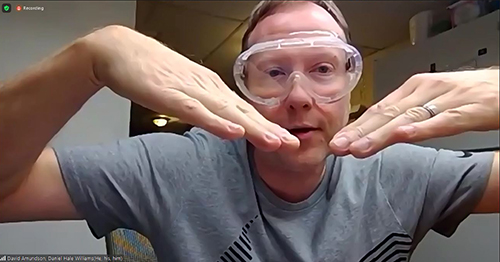
David Amundsen from Daniel Hale Williams School describes an issue he was having while doing the hands-on activity during CISTEME365's PD session on December 2, 2020.
January 4, 2021
As part of its year-round emphasis, CISTEME365 (Catalyzing Inclusive STEM Experiences All Year Round) held an all-day professional development (PD) session on Wednesday, December 2nd, for educators from eight participating schools. An initiative of the University of Illinois’ Grainger College of Engineering, in partnership with NAPE (the National Alliance for Partnerships in Equity), CISTEME365 provided the PD session via Zoom, incorporating videos and printed materials, as well as using materials from kits that had been mailed participants. The goal of the session was to provide educators with equity/inclusion training, plus allow them to experience for themselves hands-on, project-based learning activities prior to having the students in their clubs try them out.
A three-year, NSF-funded program in its second year, CISTEME365 seeks to equip educators in its eight participating Illinois schools to offer their students quality informal learning opportunities outside the classroom by forming STEM (Science, Technology, Engineering, and Math) clubs or ameliorating already-existing ones. Its goal is to target students under-represented in STEM, including African-American, Hispanic, and Native American minority students, plus female students of every ethnicity, in order to foster their interest in STEM. The hope is that they might choose careers in various STEM fields down the road. CISTEME365's overall, long-term goal is to increase the diversity in STEM.
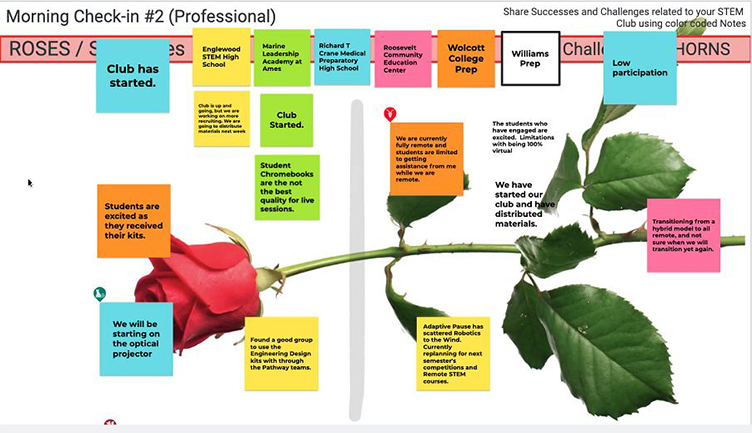
Teachers' reflections on successes and challenges encountered related to their STEM clubs posted during the morning check-in.
CISTEME365’s program is based on three pillars: IDEA teams, STEM clubs, and summer camp scholarships. For example, prior to Cohort 2’s initial summer 2020 PD session, each school had formed an IDEA (Inclusion, Diversity, Equity, and Access) team of at least three educators—a teacher, counselor, and school staff member—who are passionate about providing STEM-related opportunities for their students. This is the first of CISTEME365’s three pillars. The second is the STEM club itself, intended to provide students with learning opportunities via teaching, videos, and hands-on activities about electrical and computer engineering. The third pillar is scholarships to Illinois’ summer camps for the schools’ STEM club members. These are intended to provide students an immersive exploration of other engineering fields through more high-quality STEM experiences. An additional component was to provide periodic PD sessions, such as the December session, throughout the school year in order to provide support via training and networking to help facilitate the first two pillars: the IDEA teams and the STEM Clubs.
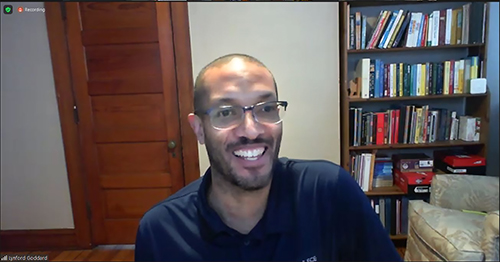
PI Lynford Goddard leads the hands-on activities during the December 2nd PD session: soldering and testing the radio phone participants built.
Participating in the December 2nd PD were around 16 educators (the number fluctuated throughout the day as educators joined or left the PD due to school or family responsibilities), including one or more IDEA team members from the eight different schools comprising the year-two cohort. Mostly from the Chicago area, participating schools included Richard T. Crane Medical Preparatory,, Englewood STEM High, Marine Leadership Academy, Roosevelt Community Education Center, Daniel Hale Williams Preparatory High, and Wolcott College Prep.
Leading the Zoom session were several CISTEME365 staff members. For instance, Lynford Goddard, CISTEME365 PI and ECE (Electrical and Computer Engineering) Professor, led the hands-on activities. Lara Hebert, Grainger Engineering’s Outreach & Public Engagement Coordinator and the CISTEME365 Program Coordinator, led a Network Improvement Community session. Megan Pollock of NAPE (the National Alliance for Partnerships in Equity) held a session on Problem-Based Learning (PBL), as well as equity-related issues such as Gender Stereotypes and Stereotype Threats.
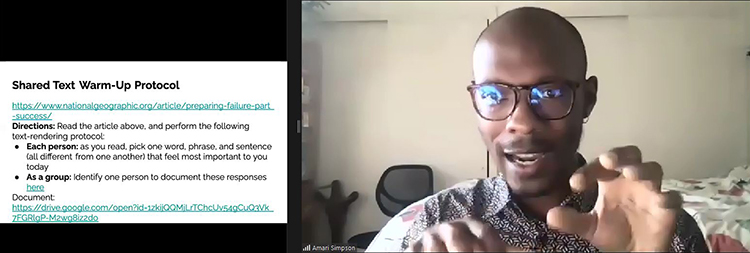
Amari Simpson leads the Engineering Design session for the December 2nd CISTEME365 PD session.
Also involved was CISTEME365 research assistant Amari Simpson, a College of Education PhD student who helps implement qualitative and quantitative findings for the project and who regularly leads warm-up PD sessions for CISTEME365 PD throughout the school year. Simpson says he got involved in this project because growing up, he attended several STEM outreach programs similar to those that CISTEME365 introduces and promotes to school educators.
“I am indebted to informal educators who have invested in me,” he reports, “and I hope to have some similar impact on young people, even if I don’t have the opportunity to meet them directly.”
The agenda for the day included a mix of lectures/videos; participant sharing via Zoom text comments, posting reflections on the Jamboard, and face-to-face discussion both to the entire group and in breakout rooms; and hands-on activities. For instance, during an Engineering Design session led by Amari Simpson, he guided a discussion about a shared article using a text-rendering protocol where educators manipulated information from the text based on what stood out to them individually. They wrapped up the session with individuals sharing their takeaways and discussing other resources for STEM clubs.
The Network Improvement Community session by Lara Hebert encouraged educators to network and communicate with each other about successes and challenges encountered with their STEM clubs. According to Hebert, their fellow educators were to serve as a “sounding board,” to provide feedback to help “set them up to improve learning.”
Megan Pollock’s session, Problem-Based Learning (PBL), addressed what PBL is, along with its benefits and challenges. “PBL starts with a wicked problem,” Pollock reports, adding that students acquire knowledge through the process.
A form of student-centered learning, PBL requires “authentic, real-world problems,” and self-direction. Also, she claims PBL “represents professional practices (or professional skills students need)” and that it encourages students to “communicate, work together, and collaborate.” Further describing PBL, she claims it is inter-disciplinary, always involves teams, is open-ended, and pushes deeper learning rather than traditional lessons. Because PBL involves teams, Pollock says it “Teaches students to value diversity on teams.”
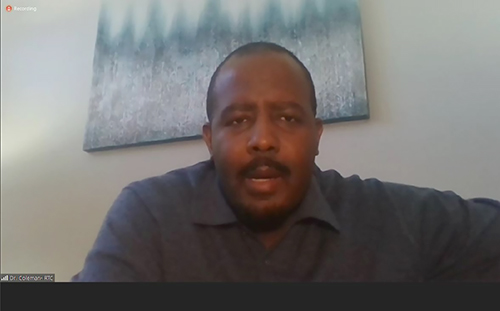
Dr. Kendall Coleman of Richard T. Crane Medical Preparatory School.
As part of the discussion during the workshop, several educators shared their take on what makes PBL effective. For instance, Dr. Kendall Coleman of Richard T. Crane Medical Preparatory School said: "Students gain knowledge and skills by working for an extended period of time to investigate and respond to an authentic, engaging, and complex question, problem, or challenge." Geniene Minkus indicated that "PBL is creating a project or problem for students to solve, accessing class content and mastery through different modalities—to me at least." Kenny Bae from Wolcott College Prep called PBL "An opportunity to connect your in-class learning to a real-world application."
Pollock also talked about Gender Stereotypes and Stereotype Threats, explaining that “When you’re the “only” in a group, you trigger stereotype threat.” So exactly what is stereotype threat?
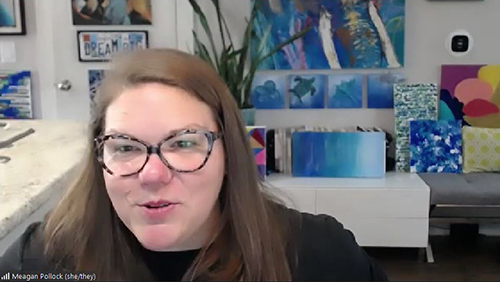
Meagan Pollock shares with the workshop participants about stereotype threat during the December 2nd CISTEME365 PD session.
“Stereotype threat," according to Pollock, "is basically an unconscious fear of validating a stereotype about you in a space in which you want to be successful. So, for example, if there is a long withstanding stereotype that women don't make good engineers, which is completely false, and I am a woman and I want to become an engineer, that can implicitly unconsciously affect my performance in that space.”
When describing stereotype threat, Pollock told a personal story about beginning her Master’s program. She'd come from a computer science program in a women's university to a Texas Tech engineering program where there weren’t many women. She recalled getting texts from different guys begging her to be in their small group for a course, asking her if she'd be willing to do the PowerPoint. They said, “Hey, you don't have to do any of the technical work. We'll do all the technical work. We just want you to make us a really beautiful slideshow.”
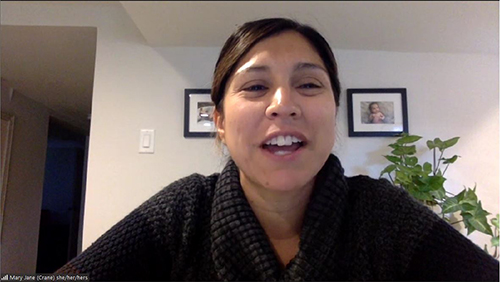
Mary Jane Nykiel from Richard T. Crane Medical Prep shares during the PD session.
Recalling the impact this had on her, she continues, “It absolutely contributed to my stereotype threat for them to ask me that question and to think, ‘Well, maybe women can't be engineers, because here I am on my first day, and they're telling me my worth is not in my technical skills, but in my PowerPoint skills.’ (And don't be mistaken. I am a mad PowerPoint slide maker!)”
Further describing stereotype threat, she shared another personal anecdote about feeling “traumatized” when her business group at Texas Instruments took the Myers Briggs test. (She uses the term traumatized tongue in cheek, but later qualifies, “It has stuck with me, so maybe it was somewhat traumatic.”
During one exercise, they’d lined up 16 panels along the wall in this huge room, each with a poster displaying the 16 different combinations of the Myers-Briggs. Each participant’s name had been placed on an 8 1/2 x 11 sheet of paper near their Myers-Briggs designation. A huge concentration of names surrounded one designation on the left end of the room, while she was the only one in another designation down at the far right.
“There was really no one down at that end of the room with their names up there,” she recalls. “So, it was just overwhelming…I already knew I was different, right, ‘cause I was a young woman in engineering, and then to see it laid out like that, it reminded everyone else that I was that different too.”
Pollock also had participants do several activities related to the topic. For example, she had participants compose an elevator pitch about equity topics, which they presented to educators in four breakout rooms made up of a cross-school constituency. Additionally, each educator had to devise an individual Action Research for Equity Project (AREP), which others in their breakout room commented on, making constructive suggestions concerning how it might be improved.
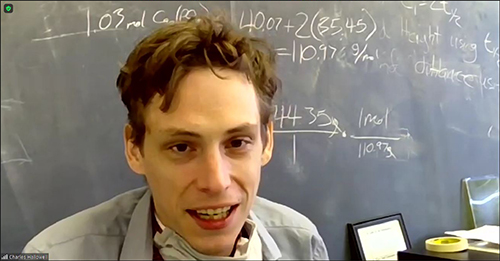
Above: Charles Hallowell shares with CISTEME365 educators during the PD session.
Below: Hallowell exhibits the soldering he's completed.
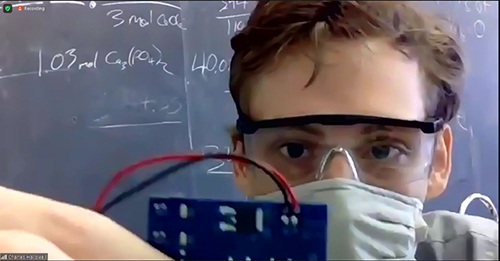
In the afternoon, Lynford Goddard held a session about soldering and testing the radio phone participants were building. Comprised of Zoom lectures and video clips, his session gave educators the opportunity to try out for themselves some of the hands-on activities available for their STEM clubs to complete at some point in the future.
One participant, Charles Hallowell, who teaches chemistry (and sometimes physics when a student wants it) at Roosevelt, shares why he got involved with CISTEME365; how he's benefitted, and which activities he particularly hopes to implement. “My hope is that through this research," he says, "I will be able to find new ways to highlight the underlying skills that make a good candidate for STEM and give kids an opportunity to explore those with success.”
Hallowell calls CISEME365’s PD “a great framework for what I already was working on personally: How do I bring the appreciation and enjoyment that I experience from studying science and engineering to people who do not have the same background as myself? My personality usually gets a lot in the door for the show, but not necessarily to participate fully.”
Hallowell intends to use a lot of the CISTEME365 lessons and modules throughout his classes and areas of responsibility. For instance, the Optics Lab is being used in Physics 2; the coding and engineering projects (like "Give Me a Hand") will be utilized in Robotics, as well as the Manufacturing Pathway. He adds that he hopes to implement the circuit board/breadboard/ soldering activities, “when I have a bit more familiarity or a student shows personal interest.”
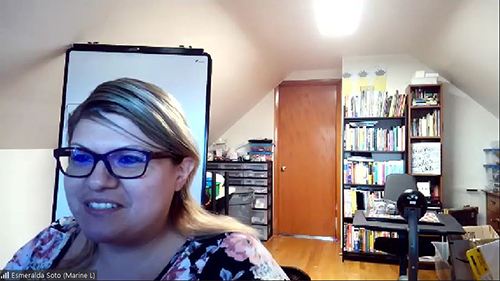
Esmerelda Soto from Marine Leadership Academy shares during the PD session.
Another educator, Esmerelda Soto, teaches Intro to Robotics and Computer Science at Marine Leadership Academy. Indicating that her counselor had received an email about the program and asked if she was interested. She jumped at the chance, admitting, “I am always interested in ways that we can promote engineering to our students.”
Soto admits that one of the benefits of participating in CISTEME365 is the materials they're supplying schools. “They provide us with supplies that we would otherwise not have access to,” she explains. “It is difficult to find vendors for CPS, and it’s difficult to get funds to pay for supplies too.”
Regarding how the PD as a whole has impacted her as an educator, she acknowledges, “I was able to see different perspectives and personal bias I may have that are directly affecting how I have been approaching my lessons.” As for the hands-on activities, Soto says she intends to continue to use the challenges and build on the soldering techniques she’s acquired.
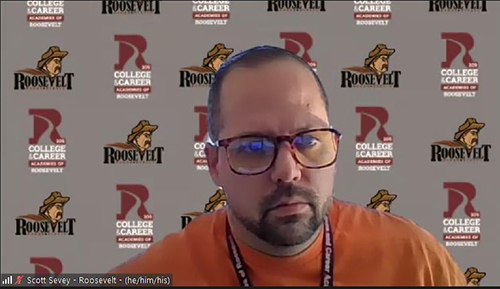 Above: Roosevelt educator Scott Sevey.
Above: Roosevelt educator Scott Sevey.Below: Sevey shows the soldering he'd done during Goddard's hands-on activity.
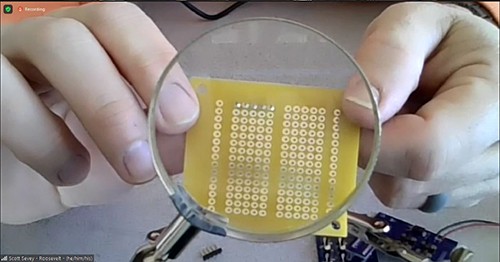
Scott Sevey, the College & Career Academy Coach at Roosevelt Community Education Center, says he and his school got involved in CISTEME365 because of its emphasis on equity.
“We serve an extremely diverse group of students from all over the Rockford area,” he explains. “Equity is a high value to us in our school, in our district, and in our community. Our participation in the CISTEME365 program provides us with a wonderful opportunity to self-reflect on the equity of our program, its practices, and its implementation.”
Sevey adds that the program is providing his school, “resources and tools to reach a broader community of students with STEM exposure,” as well as “a lens (in the form of our STEM club) to both view our practices and implementation, as well as receive actionable feedback, support, and training to help insure continued long-term growth and development.” Indicating that their STEM program benefits from this directly, he reports that his school and district “benefit indirectly, as those involved have the opportunity to highlight refined, and finely tuned principles of practice, that can be implemented to ensure equity among all of our programs.”
Acknowledging that the PD he’s received from CISTEME365 has encouraged him "to think holistically about how I approach equity issues in my school and community,” Sevey believes it will have a long-term impact on his school: “Our goal is to take the tools and resources that we have gained from the CISTEME365 program and to implement them with excellence so that our STEM program can thrive, and use them as a lens for others in our school and district to see ways to continue to improve on how we provide equitable access to programs throughout our district.”
What kind of impact do CISTEME365 staffers perceive that their program as a whole and/or during the recent PD has had on educators? Amari Simpson shares that when he was a teacher, he never had an opportunity to collaborate with his school’s counselor on an initiative his school was promoting. “Many educators are also in similar situations where this PD provides a new opportunity to collaborate in ways unfamiliar to traditional school practices,” he indicates. “Folks are excited to make connections within and between their schools, and it will be neat to see how this continues for each school beyond CISTEME365.”
Having worked with these educators for 10 days of PD from July until December, Pollock reports on the program’s impact as a whole: “They are definitely increasing their awareness of the needs of the marginalized and minoritized students within their sphere of influence, and they’re learning to consider different strategies and different root causes for why they aren't participating in the way that they want them to.”
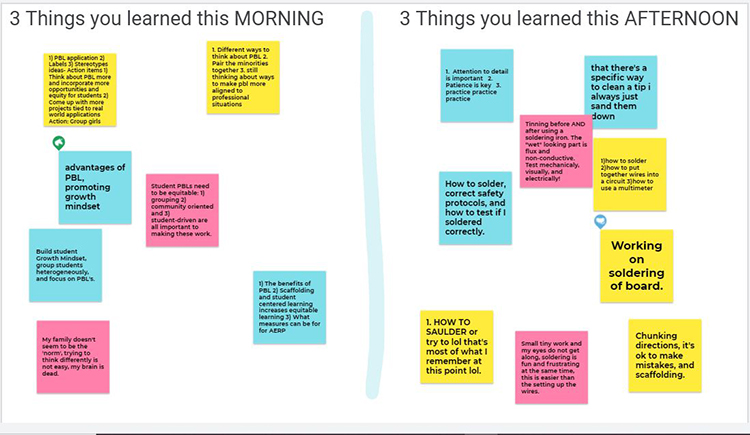
Teachers' reflections posted on the Jamboard detailing what they'd gotten out of the PD session.
Pollock also believes the educators are “learning how to create equitable learning environments, not only within their STEM camps, but within their classrooms—within how they are counseling other students.” She adds that while everything they’re teaching the educators is directed at their STEM clubs, it's really “how to be an inclusive individual, how to increase your awareness and your lens of what's happening with students so that you can better apply different strategies, have an increased understanding of what's happening with different students from an intersectional lens—a lens that looks at the overlapping layers of identity around race and gender and class and other dimensions of identity.”
She adds that she’s also starting to see teachers' Action Research Projects come together in a much better way than those from last year, which she thinks is due in part to CISTEME365’s organization and efforts at getting them moving. “So, I'm excited to see what projects that they come up with,” she explains. “I'm taking a more active coaching approach with them this year really aimed at helping them to be successful in applying what they're learning at their schools.”
Author/Photographer: Elizabeth Innes, Communications Specialist, I-STEM Education Initiative
More: CISTEME365, Electrical and Computer Engineering, Teacher Professional Development, 2021
For additional istem articles on CISTEME365, please see:
- CISTEME365 Virtual Institute Equips Teachers to Expose Underserved Students to STEM Via Extracurricular STEM Clubs
- MSHS STEM Club Seeks to Pique High Schoolers’ Interest in STEM Via Hands-on Activities, Exploring STEM Careers
- Banerjee and Bose Empower/Recharge Educators During CISTEME365 Session About Power and Energy
- Five Schools Tap into CISTEME365 Resources to Begin STEM Clubs, Pique Student Interest in STEM
- Meagan Pollock Encourages CISTEME365 Educators to Reach and Teach Every Student
- CISTEME365 Seeks to Increase Experiences for Underrepresented Students in STEM—Trains Teachers to Start STEM Clubs
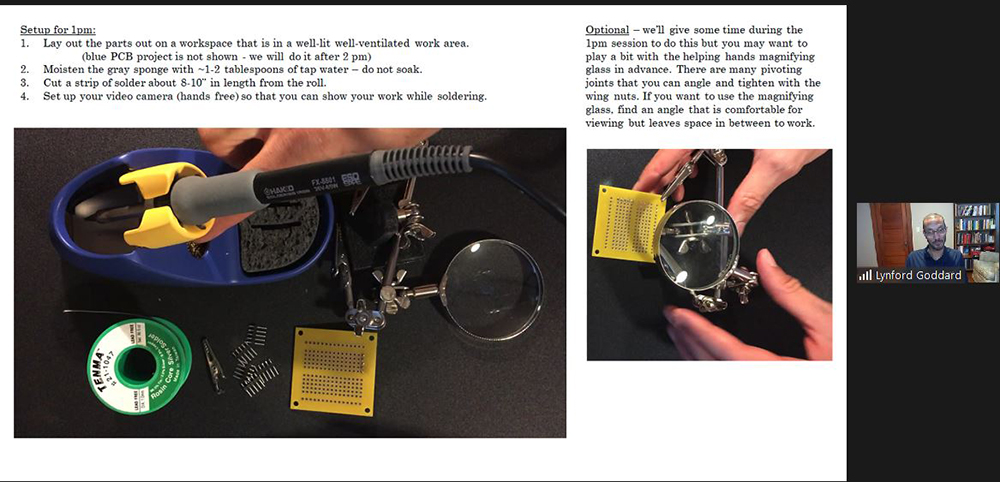
PI Lynford Goddard shows a video about soldering prior to having participants do the hands-on activity.













.jpg)
















